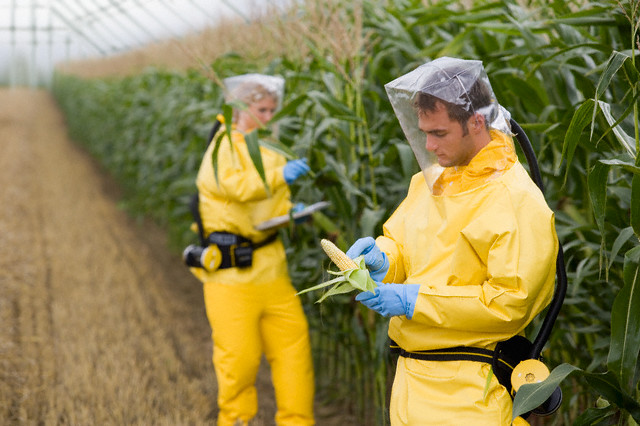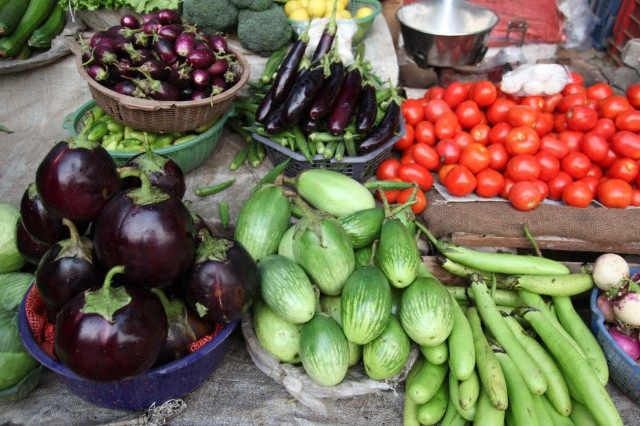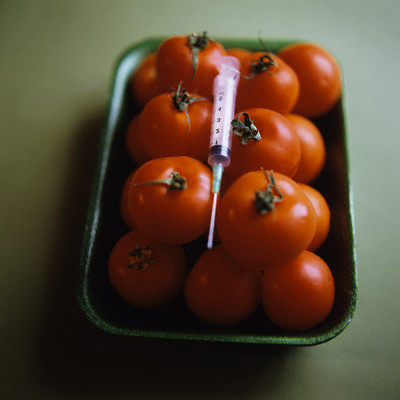- Преподавателю
- Иностранные языки
- Интегрированный урок: «ГМО» (биология + английский язык) 11 класс
Интегрированный урок: «ГМО» (биология + английский язык) 11 класс
| Раздел | Иностранные языки |
| Класс | 11 класс |
| Тип | Конспекты |
| Автор | Бруенкова О.Б. |
| Дата | 19.12.2014 |
| Формат | doc |
| Изображения | Есть |
Интегрированный урок: «ГМО» (биология + английский язык)
Авторы: Сурикова М.В., Бруенкова Ольга Борисовна
Образовательное учреждение: ГОУ Республиканский классический лицей РА
Предмет: Биология и английский язык.
Класс: 11 (с углубленным изучением английского языка)
Тема: «ГМО»
Время реализации урока: 45 минут.
Цель урока: формирование информационно-коммуникативной компетенции обучающихся, развитие критического мышления.
Задачи:
-
Образовательная: научить учащихся извлекать информацию из разных источников на русском и иностранном языках с целью выявления главной идеи; расширение словарного запаса.
-
Развивающая: формировать навыки поискового чтения и чтения с полным пониманием содержания, развивать критическое мышление .
-
Воспитательная: формировать умение сотрудничать в группе, работать индивидуально и в парах, оформлять свои ответы на вопросы.
-
Стадия вызова.
Учитель Б.: Что означает аббревиатура «ГМО»? Слайд 1. Что такое ГМО? Слайд 2. Обращаете ли вы внимание на наличие значка ГМО, когда покураете продукты? Слайд 3. Купите ли вы такой продукт? Слайд 4. На уроке нам предстоит ответить на вопрос: ГМО - это наше будущее или путь в никуда? Слайд 5.
-
Стадия осмысления.
Учитель А.Я.: Материал вам будет предложен на английском языке. Прочитайте информацию на слайде 6-7, выполните задание на слайде 8-9.
Учитель А.Я.: Group work. Слайды 13-14. Read the text and present your viewpoint in English. (10 минут)
3.Стадия рефлексии. Презентация результатов групповой работы.
Домашнее задание на слайде 15.
ПРИЛОЖЕНИЕ 1
Genetically modified food around the world
Jodie Humphries

No Comments
Genetically modified food or GM food, to use the abbreviated term, isn't a subject that needs an introduction. Next Generation Food has already looked into whether genetically engineered food has benefits in the article 'Genetically engineered food: kill or cure?' and millions of websites and newspapers have dedicated pages and pages to the subject of whether GM foods should, or shouldn't be used.
In comparison with conventional crop seeds, genetically modified seeds are more expensive, but the value of GM technology is considered 'worthy' of such an increase according to the manufacturers because the seeds have beneficial traits such as resistance against weeds, pests, disease or other factors, according to geneticallymodifiedfood.co.uk.
Manufacturers also cite that the increased cost of the seeds serves to fund further research into genetic modification techniques and developments. In addition, the markets for GM seeds and conventional ones are considered to be quite separate, which means that costs will similarly vary.
There are a number of common genetically modified foods currently on the market. Depending on where you live and the labelling laws around GM foods, you might want to avoid some of these foods unless they are specifically labelled as being free of GM ingredients.
Common genetically modified food
At present, the two main types of GM crops being grown are ones that tolerate herbicides and ones that are toxic to certain kinds of pests. In the first case, a GM crop is engineered to tolerate a herbicide that kills all other plants and weeds. In this way, the GM crop does not have to compete with other plants for nutrients, water and light. The idea is that there will be higher yields from the GM crops if all other competing plants are eliminated. In the second example, a GM crop is engineered to produce a specific toxin that kills the pests who feed on it. This is commonly done for the cotton plant, although some GM foods are also engineered to produce the toxin as well.
Soybeans are a commonly modified food. One type from Monsanto is resistant to herbicides. The herbicide resistant gene is removed from bacteria and then inserted into soybeans.
Corn is another common GM food; it is engineered to be resistant to specific pesticides and tolerates amounts that would typically affect the crop.
Tomatoes are frequently genetically modified types of food, although the modification of tomatoes is different than some of the other crops. GM tomatoes will generally be engineered to maintain their quality for longer periods of time. A tomato will be modified so that it does not have a substance that would cause non-GM tomatoes to become rotten and degraded.
In this way, the process of genetic modification improves the quality of tomatoes and allows them to remain on shelves for longer periods of time while still staying fresh and appealing.
Other commonly modified types of food include potatoes and rapeseed. Sugar cane is another GM food that is resistant to some pesticides.
Sweetcorn is one of the GM foods that produce a toxin that kills insects, which serves to reduce problems with pests. Yet another commonly modified food is rice, which has been called 'golden rice' due to it being modified to contain high levels of vitamin A.
Genetically modified foods in Britain
Any GM foods intended for sale in the European Union are subject to a rigorous safety assessment, which is the responsibility of the European Food Safety Authority (EFSA), The Food Standards Agency report.

However, the final decision for authorisation still rests with Member States, which vote on each GM food. In the event of an inconclusive vote, the Council of Ministers votes, and if they cannot agree the final decision rests with the European Commission.
Consumers in the UK find that current labelling rules for GM foods are inadequate and they are confused by labelling information, says a new report commissioned by the UK's Food Standards Agency, Exploring Attitudes to GM Foods.
In the study, independent researchers from the National Centre for Social Research found that consumers think that food labels should list the GM ingredients in foods produced using GM processes, or in animal feeds which are currently not labelled.
While elsewhere, "Britain must embrace genetically modified crops and cutting-edge developments such as nanotechnology to avoid catastrophic food shortages and future climate change," said the government's chief scientist, Professor John Beddington said at the beginning of this year in the article 'Britain must launch GM food revolution, says chief scientist'.
He argued that new technologies such as GM will be critical in meeting economic, environmental and social goals. Beddington said the revolution is needed primarily to counter climate change and help provide food for the nine billion people worldwide expected within 30 years.
"It is [also] predicted that demand for energy will rise by around 50 percent, and for fresh water by 50 percent, all of which must be managed while mitigating and adapting to climate change. This threatens to create a 'perfect storm' of global events," he said.
Genetically modified foods in America
In America, genetically modified foods have come to the local supermarket, even though most Americans don't want them and many believe they're dangerous. A CBS poll found that 53 percent of Americans wouldn't buy food they knew had been genetically modified. But, there's no easy way to know which foods contain genetically modified ingredients.
About 60 to 70 percent of products on grocery store shelves contain at least one genetically engineered element. These foods include corn, strawberries, tomatoes, lettuce, potatoes, soybean, and canola.
The public is generally unaware when they purchase genetically modified foods (called GM or GMO, short for genetically modified organism since manufacturers and producers aren't required to disclose the information on labels. The European Union, Japan, China, Korea, Australia, and New Zealand require GMO foods to be labelled. And despite a CBS News poll that showed a majority of Americans want labeling, no such laws exist.
Genetically modified foods in China

Chinese food and agricultural experts have said there is no evidence to prove that genetically modified crops are unsafe for people and the environment, China Daily reported.
Huang Dafang, director of Biotechnology Research Institute under the Chinese Academy of Agricultural Sciences, said that the genetically modified crops are of great significance to the sustainable development of agriculture and China's competitiveness in global arena.
"It could help increase the output to ease the food supply strain caused by the shrinking of farmland," Huang said.
China, which is home to 1.3 billion people, has put the food security on high agenda in its national development planning.
Wu Yongning, a food safety specialist with the Chinese Center for Disease Control and Prevention, said current studies have not proved genetically modified food harmful to human health. Wu said that genetically modified food have to pass scrupulous testing in order to get on shelves, including laboratory and field studies, toxicity and allergy tests.
Greenpeace in China
Greenpeace China has published a report which teaches people how to distinguish genetically modified food sold on the market.
Guidance for Avoiding GM Food provides a list of about 400 international and domestic brand products and whether they use genetically modified food in their products.
Companies that use GM food get red marks and others are labelled green. Red manufacturers include food giant Nestle and the Yili dairy group as they have not declared themselves GM food-free. Green companies included Coca- Cola and China Resources that produces Snow beer.
China's two biggest dairy producers Yili and Mengniu both fell into the red zone from the green in the last two years, for failing to make a non-GM food promise for their ice cream to customers.
"A good enterprise should make continuous efforts to maintain a high quality in their products, not downgrade product and service," said Wang Weikang, Greenpeace's program director.
Eighteen baby food producers were included in the red section including Nestle and Wondersun, compared with only seven green.
"China largely forbids growing GM farm plants, but food producers can import genetically modified soybean, corn and many other agricultural products, mainly from the US," Wang said.
"Although it has not been proven GM food is hazardous to people, scientists don't rule out its harm to human health in the long run."
Are genetically modified foods the answer?

So are genetically modified foods the answer to world hunger? In a world where around 1.02 billion people are hungry and every day, almost 16,000 children die from hunger-related causes - the equivalent of one child every five second, many believe that genetically modified food is the answer. But how can it be the answer when there is so many people against the idea of GM food? The debate of GM food is set to continue for years to come, as currently it doesn't seem like anyone is going to be willing to give any ground on the subject.
Related News:
A global perspective - Food Safety - NG Food Europe | GDS Publishing |Genetically modified crops set to be more widespread |Public opinion food technologies |NG Food Europe - The future of food technology |Food effects climate change
ПРИЛОЖЕНИЕ 2
The Non-GMO Project
The Non-GMO Project is a non-profit organization, created by leaders representing all sectors of the organic and natural products industry in the U.S. and Canada, to offer consumers a consistent non-GMO choice for food and products that are produced without genetic engineering or recombinant DNA technologies.
The Project
The Project was originally started by a group of natural food retailers who wanted to provide their customers with more information on the GMO status of their products. It was soon realized that a third party verification system along with a standardized consensus based definition of non-GMO was needed to evaluate products. Working with industry leaders the Non-GMO Project Product Verification Program began enrolling products in 2008. FoodChain Global Advisors, a part of Global ID Group, provided the technical and scientific foundation for the endeavor. Encompassing each level of the food chain from seeds to finished products, the Project provides a system for ensuring viable non-GMO alternatives into the future.
The Standard
The Non-GMO Project Standard's goal is to assist farmers, processors, and manufacturers in avoiding GMO contamination. The Standard outlines a process based system for ensuring best practices for avoiding GMO's. Methods such as segregation, traceability, risk assessment, sampling techniques, and quality control management are emphasized in the Standard.
Product Verification
The Non-GMO Project's Product Verification Program (PVP) assesses ingredients, products, and manufacturing facilities to establish compliance with the Non-GMO Project Standard. The PVP process is managed through a web-based application and evaluation program developed for the Project by FoodChain Global Advisors, the central administrative body of the PVP.
Seal
The Non-GMO Project seal verifies that a product has met the requirements set forth by the standard. The goal of the claim is to communicate that a product meets best practices for GMO avoidance as set forth by the Non-GMO Project standard.
History
In 2003 in response to customers who were concerned about GM soy lechitin, employees of The Natural Grocery Co. in Berkeley, began the "People Want to Know Campaign." Its' goal was to provide an informed choice regarding GM products in the store. The results were mixed as there was no industry wide definition as to what non-GMO meant. In 2001, The Big Carrot Natural Food Market in Toronto, Ontario, after a year and a half of research, started a non-GMO purchasing policy discontinuing products that were not confirmed by the manufacturer to be non-GMO. Due to the lack of an authoritative definition, the Big Carrot began to look for a more reliable method of providing non-GM products. In 2005, The Natural Grocery Co. and The Big Carrot worked together to form The Non-GMO Project with the goal of creating a standardized definition of non-GMO. The Project worked with FoodChain which provided the scientific and technical expertise that would make the Project's goals feasible. In the Spring of 2007, the Board of Directors was expanded to include representatives from more stakeholder groups in the natural products industry. This board then formed advisory boards for technical and policy issues.


